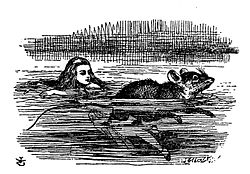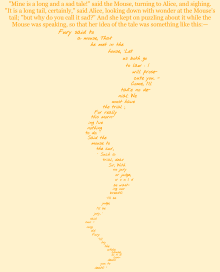
The Dodo is a fictional character appearing in Chapters 2 and 3 of the 1865 book Alice's Adventures in Wonderland by Lewis Carroll. The Dodo is a caricature of the author. A popular but unsubstantiated belief is that Dodgson chose the particular animal to represent himself because of his stammer, and thus would accidentally introduce himself as "Do-do-dodgson".

Alice's Adventures in Wonderland is an 1865 English novel by Lewis Carroll. It details the story of a young girl named Alice who falls through a rabbit hole into a fantasy world of anthropomorphic creatures. It is seen as an example of the literary nonsense genre. The artist John Tenniel provided 42 wood-engraved illustrations for the book.

The Hatter is a fictional character in Lewis Carroll's 1865 book Alice's Adventures in Wonderland and its 1871 sequel Through the Looking-Glass. He is very often referred to as the Mad Hatter, though this term was never used by Carroll. The phrase "mad as a hatter" pre-dates Carroll's works. The Hatter and the March Hare are referred to as "both mad" by the Cheshire Cat, in Alice's Adventures in Wonderland in the sixth chapter titled "Pig and Pepper".
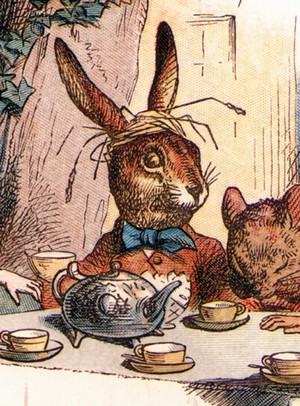
The March Hare is a character most famous for appearing in the tea party scene in Lewis Carroll's 1865 book Alice's Adventures in Wonderland.

The Queen of Hearts is a fictional character and the main antagonist in the 1865 book Alice's Adventures in Wonderland by Lewis Carroll. She is a childish, foul-tempered monarch whom Carroll himself describes as "a blind fury", and who is quick to give death sentences at the slightest offense. One of her most famous lines is the oft-repeated "Off with his/her head!" / "Off with their heads!"

Alice in Wonderland is a 1951 American animated musical fantasy comedy film produced by Walt Disney Productions and based on the Alice books by Lewis Carroll. The thirteenth release of Disney's animated features, the film premiered in London on July 26, 1951, and in New York City on July 28, 1951. It features the voices of Kathryn Beaumont as Alice, Sterling Holloway as the Cheshire Cat, Verna Felton as the Queen of Hearts, and Ed Wynn as the Mad Hatter. Walt Disney first tried to adapt Alice into a feature-length animated film in the 1930s and revived the idea in the 1940s. The film was originally intended to be a live-action/animated film, but Disney decided it would be a fully animated film.
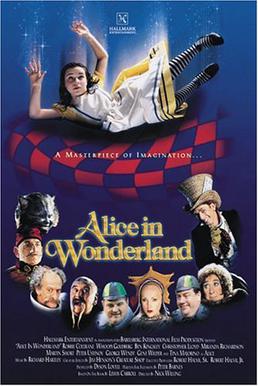
Alice in Wonderland is a 1999 made-for-television film adaptation of Lewis Carroll's books Alice's Adventures in Wonderland (1865) and Through the Looking-Glass (1871). It is currently the last production to adapt the original stories and was first broadcast on NBC and then shown on British television on Channel 4.

Lewis Carroll's books Alice's Adventures in Wonderland (1865) and Through the Looking-Glass (1871) have been highly popular in their original forms, and have served as the basis for many subsequent works since they were published. They have been adapted directly into other media, their characters and situations have been appropriated into other works, and these elements have been referenced innumerable times as familiar elements of shared culture. Simple references to the two books are too numerous to list; this list of works based on Alice in Wonderland focuses on works based specifically and substantially on Carroll's two books about the character of Alice.

The Looking Glass Wars is a series of three novels by Frank Beddor, heavily inspired by Lewis Carroll's 1865 novel Alice's Adventures in Wonderland and its 1871 sequel Through the Looking-Glass. The premise is that the two books written by Lewis Carroll are a distortion of the "true story".

Fushigi no Kuni no Alice is an anime adaptation of the 1865 novel Alice's Adventures in Wonderland which ran on the TV Tokyo network and other local stations across Japan from October 10, 1983 to March 26, 1984. The series was a Japanese-German co-production between Nippon Animation, TV Tokyo and Apollo Films. The series consists of 52 episodes, however, only 26 made it to the US.

The King of Hearts is a character from the 1865 book Alice's Adventures in Wonderland by Lewis Carroll. He is the husband of the Queen of Hearts.
"The Mouse's Tale" is a shaped poem by Lewis Carroll which appears in his 1865 novel Alice's Adventures in Wonderland. Though no formal title for the poem is given in the text, the chapter title refers to "A Long Tale" and the Mouse introduces it by saying, "Mine is a long and sad tale!" As well as the contribution of typography to illustrate the intended pun in this title, artists later made the intention clear as well. Translators of the story also encountered difficulty in conveying the meaning there, part of which was not recognised until well over a century later.

The Dormouse is a character in "A Mad Tea-Party", Chapter VII from the 1865 novel Alice's Adventures in Wonderland by Lewis Carroll.
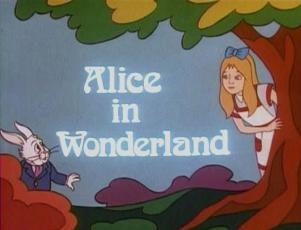
Alice in Wonderland is an Australian 51-minute direct-to-video animated film from Burbank Films Australia originally released in 1988.

Alice in Wonderland is a 1949 French film based on Lewis Carroll's 1865 fantasy novel Alice's Adventures in Wonderland. Directed by Dallas Bower, the film stars Carol Marsh as Alice, Stephen Murray as Lewis Carroll, and Raymond Bussières as The Tailor. Most of the Wonderland characters are portrayed by stop-motion animated puppets created by Lou Bunin.

Alice in Wonderland is a 1915 American silent dark fantasy adventure film adaptation of Lewis Carroll's classic 1865 novel, Alice's Adventures in Wonderland, directed and written by W. W. Young and starring Viola Savoy as Alice.
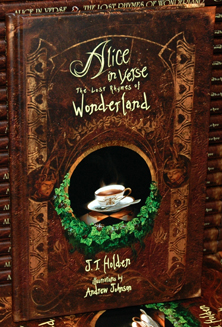
Alice in Verse: The Lost Rhymes of Wonderland (2010) is a reimagining of Lewis Carroll's 1865 novel Alice's Adventures in Wonderland written by British-American author J.T. Holden. It tells the story of Alice's Adventures in Wonderland in 19 rhyming poems, each written in the same style as Lewis Carroll's original verse. The book includes 36 illustrations by American artist Andrew Johnson.

Pat is a fictional character in Lewis Carroll’s 1865 book Alice's Adventures in Wonderland. He appears in the chapter "The Rabbit Sends in a Little Bill." He works for the White Rabbit like his friend Bill the Lizard. Carroll never gives any description of the character other than being a gardener, and his species has been widely debated, with evidence showing he is likely to be a monkey or a guinea pig.
Alice in Wonderland and Through the Looking-Glass is a 2001 stage adaptation of Lewis Carroll's 1865 novel Alice's Adventures in Wonderland, and the 1871 novel Through the Looking-Glass. It was written by Adrian Mitchell.
